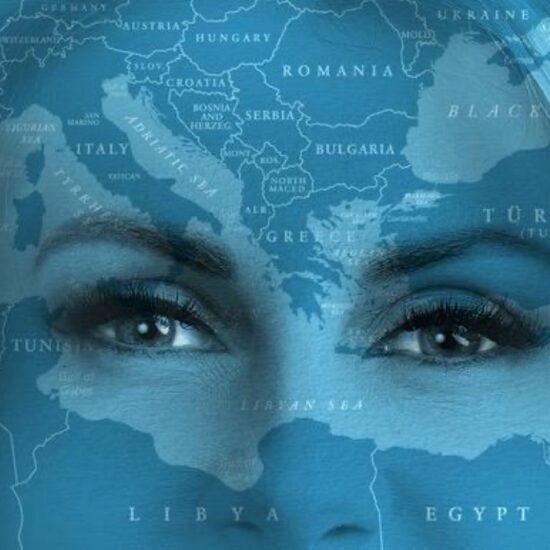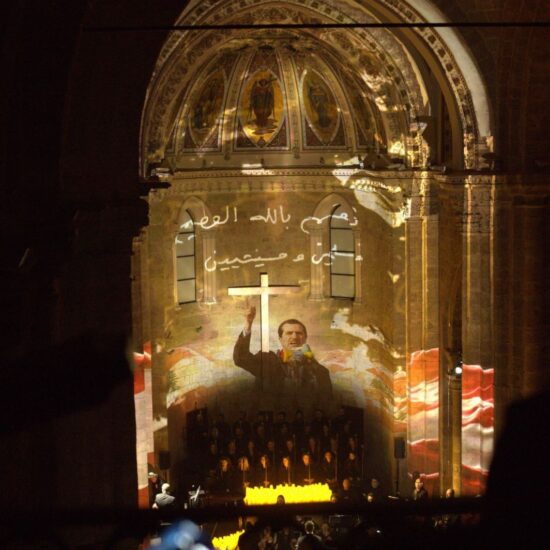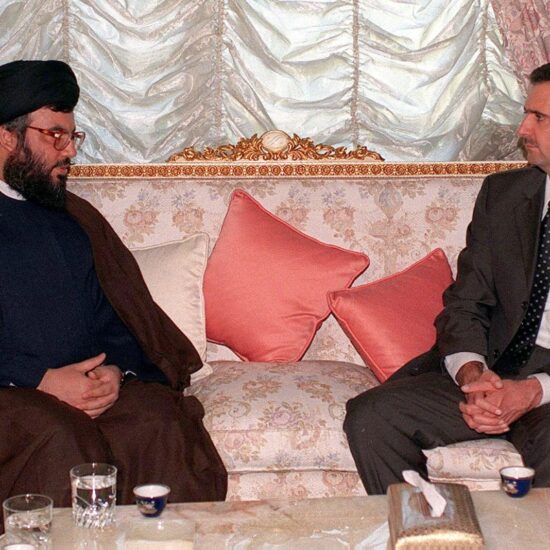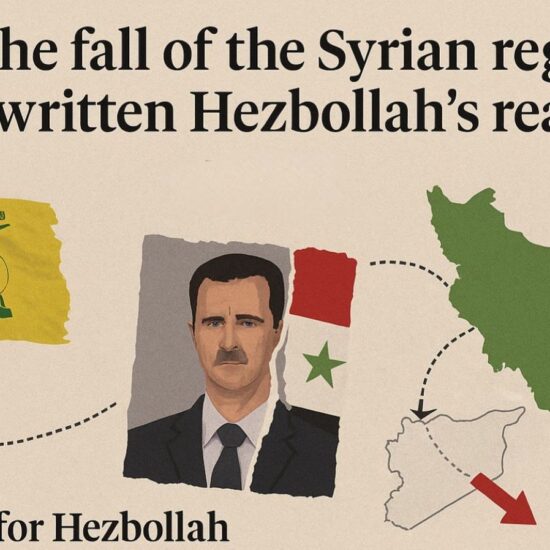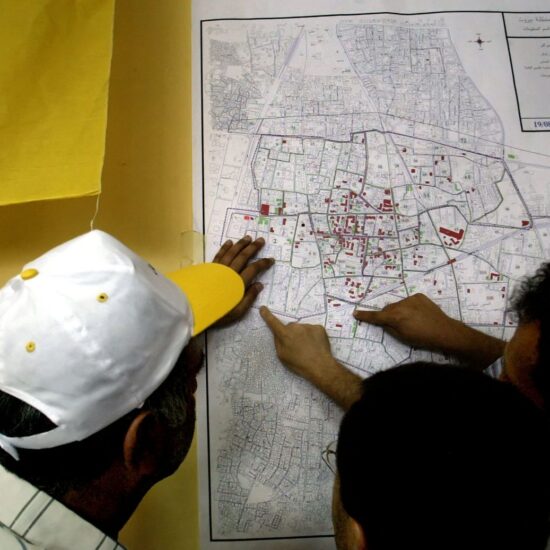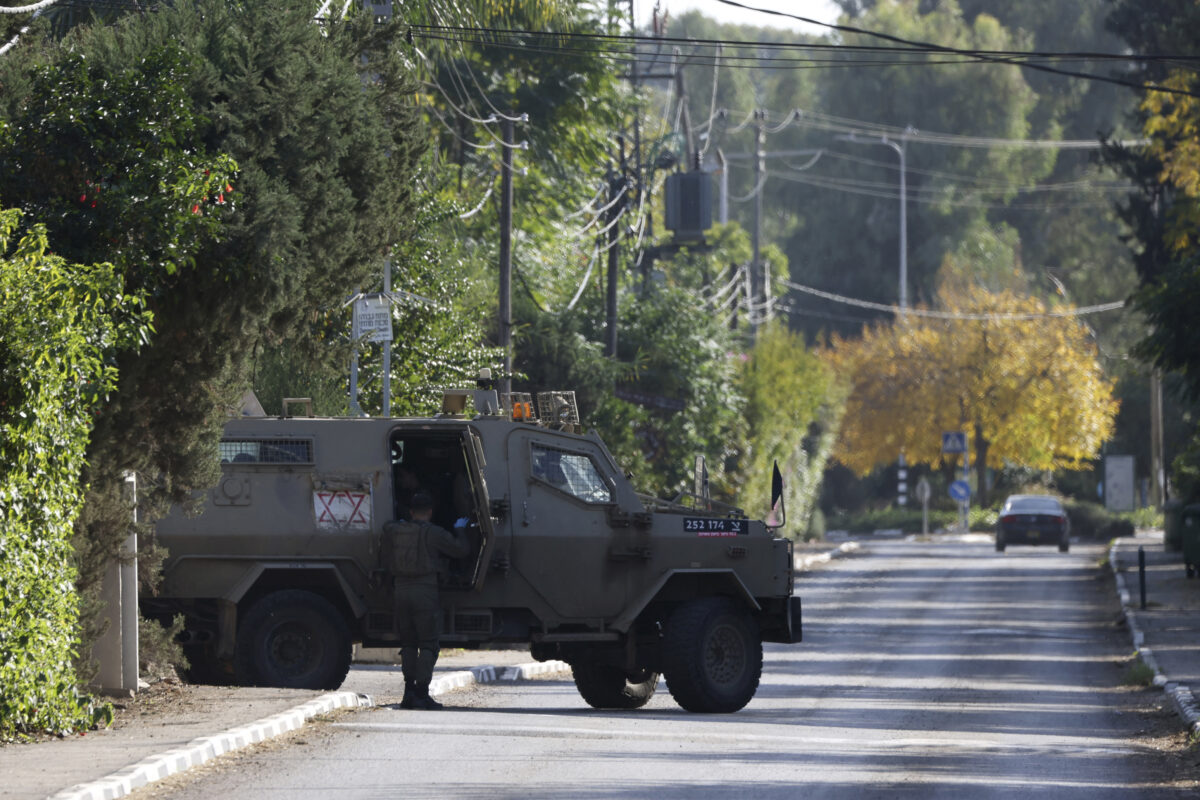
The second act of the Israeli offensive on Gaza, Jenin and the unpunished massacre of children, More civilians killed in south Lebanon, Two IRGC casualties in Syria raise expectations for a direct Iranian response, Israeli intelligence officers leave Qatar, COP28 discusses global environmental emergency, White phosphorus attacks pose a serious threat to health and environment, The failure of Israeli greenwashing, The big absence of Bashar al-Assad, Newly-discussed media law stifles freedom of expression and press in Lebanon, AUB seminar “Lebanon in its Second Century: A Forward Vision” third session discusses security sector’s reforms
While the truce was postponed, genocide was ongoing. Now that the truce has officially ended, the effects of the same genocide can only worsen.
“Every child killed in Gaza today would be alive if we had a ceasefire yesterday,” author Yousef Munayyer wrote, at the end of October, in a tweet that went viral. Despite such words forcing us to reckon with the genocidal violence that Palestinians in Gaza are re-facing after Israeli bombardments on the Strip resumed on Friday, following the week-long truce, they omit a fundamental detail: that while the world caught its breath praising diplomatic effectiveness and reviving discussions on peaceful two-state solutions, children – among other civilians – continued to die in Gaza.
James Elder, a spokesperson for the UN Children’s Agency in Gaza, told reporters by video link that hospitals in the strip were full of children with burns and shrapnel wounds and gastroenteritis from drinking dirty water. Cited by Reuters, he reported meeting a lot of parents, saying that “they know exactly what their children need, they don’t have access to safe water and it’s crippling them,” as he described seeing one child with part of his leg missing lying on the hospital floor for several hours, without receiving treatment for lack of medical staff, while other injured children were lying on makeshift mattresses in car parks and gardens outside.
Moreover, several reports from Gaza hospitals stated they have resorted to performing caesarean sections and amputations without anesthetic, making it impossible for those patients in the north to evacuate south, while surgeon Ghassan Abu Sitta repetitively posted that hospitals had run out of blood for transfusions, causing patients to die after surgery, and that those wounded by Israel’s bombing were, already since early November, “no longer being treated for their injuries but instead being stabilized as best they can.”
In fact, to the over 15,500 dead, in the count of the victims of the brutal Israeli aggression, we must add the 41,000 wounded, whose broken limbs, amputations, physical traumas, blindness, and other disabilities that defy imaginable limits, have not found much relief in the too-short 168 hours of break which allowed the mutual exchange of hostages, and ended on Friday morning.
Despite an increasing number of aid trucks having entered the besieged enclave during the past week, that nevertheless did not even reach 21 percent of those insured before the crisis, on December 2, the Palestinian Ministry of Health in Gaza stated that the bed occupancy rate at operational hospitals is standing well over capacity, at 171 per cent, while at the intensive care units the occupancy rate is up to 221 per cent. Moreover, only four hospitals in the north are partially operating and admitting patients, with only limited services, none of them having surgery capacity. The remaining 12 hospitals in the south are, until now, partially functional. The bed capacity across Gaza has declined from 3,500 prior to the war to 1,400 presently, amid a surge in those seeking treatment. Only one of the currently functional hospitals has the capacity to treat critical trauma cases or perform complex surgery, according to the World Health Organization (WHO).
Next to the complete collapse of Gaza’s healthcare system, Israel’s total blockade of the Strip has prevented necessities – food, water, electricity and fuel – from entering, suffocating the already-critical medical services and fully preventing doctors from reaching wounded to attempt to save their lives.
As a spokesperson for the World Health Organization alarmingly said on Tuesday, cited by Reuters, there is a risk that more people will die from diseases than from bombings in Gaza, if the enclave’s health system is not quickly restored. Margaret Harris, from the WHO, described the collapse of al-Shifa Hospital in the northern Gaza Strip as a “tragedy”, expressed concern about the detention of some medical staff by Israeli forces, and also repeated worries about a rise in infectious diseases, particularly diarrheas’ in infants and children, with cases for those aged five and older surging to more than 100 times normal levels by early November. “Everybody everywhere has dire health needs now because they’re starving because they lack clean water and (they’re) crowded together,” Harris said.
This kind of slow violence – the policy of ‘starve or surrender’, or the so-called ‘weaponization of starvation’ – is the normal modus operandi of the Israeli occupation. Before October 7, Israel was already controlling how much food entered Gaza down to the exact calorie, as a report published in 2012 by the Israeli newspaper Haaretz showed. Electricity, water, fuel and medical supplies have been similarly monitored for years, debilitating the entire population and slowly moving them towards death.
But as we have seen clearly since October 7, this slow violence also has different speeds. In her book ‘The Right to Maim: Debility, Capacity, Disability,’ for example, author Jasbir Puar observed that the Israeli occupation’s policies on the Palestinian people made it evident a strategy of creating injury and maintaining Palestinian populations as perpetually debilitated, and yet alive, in order to control them.
Fast death, the one that takes the form of airstrikes and continuous bombardments, in the Israeli genocidal war on Gaza, proved to be able to converge with a slower rhythm of violence, deprivation and colonial oppression, overlapping with the already established intention to maim, thus to control. And if what Palestinians have been facing for the past two months is nothing but a continuation of the Nakba, to that end, Israel has been persuading non-stop its objective of the total annihilation of the Strip: not only by causing an extraordinary number of deaths among civilians, but also forcibly displacing them, seizing control of their land, and debilitating them.
Despite the US having called for a campaign “deconflictualised” from electricity, water, humanitarian sites and hospitals in southern and central Gaza, meaning avoiding attacks on these types of infrastructure, the IDF seems solid in its aim to continue to weaken and disable Palestinians – hence to kill them slowly – regardless of a new truce being announced: so to eclipse and overshadow Israel’s culpability for the deaths that will result from the conflict over the course of decades.
In Lebanon
Unhealthy: Lebanon participated at the United Nations Climate Change Conference (COP28) held in the United Arab Emirates from November 30th and lasting until December 12th, with the presence of Caretaker Minister of Public Health, Firas Al-Abiad.
The annual conference, bringing together world leaders to address the severe human intervention in the climate system, saw Lebanon’s unique position taking the stage, as Minister Al-Abiad specifically addressed his speech on health issues, marking it as the first COP that explicitly centers on health-related discussions.
Through his participation, Minister Al-Abiad emphasized “the urgent need for Lebanon to prioritize health-related risks in the climate change conference,” recognizing the undeniable impact of environmental factors on human health, and affirming “the urgent necessity to take measures to develop and adapt healthcare systems in response to the climate change crisis,” as the National News Agency reported.
Earlier this year, Lebanon’s Ministry of Public Health formally supported measures associated with the 2021 United Nations Climate Change Conference (COP26) through an official message dated March 26, 2023. As part of this initiative, Lebanon pledged to prioritize the health needs of its population, considering environmental and sustainability challenges faced by healthcare facilities. The statement concluded by affirming the Ministry’s steadfast commitment to integrating climate adaptation into public health policies and aligning efforts with international policies to protect citizens and future generations.
This year, the Lebanese delegation was the largest in the history of Lebanon’s participation in climate summits and conferences related to climate change, as pointed out by the Environment Minister Nasser Yassin in an interview with LBCI.
White phosphorus: Despite Al-Abiad’s active participation in the COP28, no mention was made of the long-term effects of white phosphorus resulting from Israeli heavy bombing across Lebanon’s southern borders. A condemnation of Israeli attacks on the Lebanese environment came only on Saturday, with the intervention of caretaker Prime Minister Najib Mikati.
Following the temporary truce between Hamas and Israel that Hezbollah unofficially took part in – on its own initiative -, southern Lebanese farmers returning to their lands have found their crops ravaged by white phosphorus and their work hindered by unexploded munitions. This posed a hazard to returnees, who could accidentally re-ignite remnants of the munition and inhale the resulting smoke, as well as touch residue and absorb the chemical through their skin.
The long-term effects of white phosphorus, a chemical munition which produces fires and smoke that is toxic to plants and animals, on soil, crops and health, are yet unknown, and Lebanese authorities are still grappling with how to issue guidelines for farmers in affected areas. What is known is that it ignites when exposed to atmospheric oxygen and continues to burn until it is deprived of oxygen or exhausted: its chemical reaction can create intense heat (about 815°C), light, and smoke. As a result, upon contact – as Human Rights Watch reported in releasing a question and answer document on the topic in mid-October -, white phosphorus can burn people, thermally and chemically; its fragments can exacerbate wounds even after treatment and can enter the bloodstream and cause multiple organ failure; not to mention that already dressed wounds can reignite when dressings are removed and the wounds are re-exposed to oxygen. Even relatively minor burns are often fatal. For survivors, extensive scarring tightens muscle tissue and creates physical disabilities.
Therefore, Israel’s use of white phosphorus in military operations in Gaza and Lebanon puts civilians at risk of serious and long-term injuries. When used in densely populated areas, moreover, its usage magnifies the risk to civilians and violates the international humanitarian law prohibition on putting them at unnecessary risk.
And if the long-term effects on survivors – such as psychological trauma, painful treatment and social exclusion resulting from scars – are hardly surmountable, so are those on the environment. According to experts and scholars from the AUB Nature Conservation Center (AUB-NCC) – leading multidisciplinary academic center addressing nature conservation in the MENA region -, decontamination from white phosphorus will require years, if not decades. In a recently published report, using data from the Minister of Agriculture, AUB-NCC addressed the socio-environmental impact of white phosphorus ammunition in south Lebanon, conducting both analysis and risk mitigation strategies.
More victims: Cross-border clashes between Hezbollah and Israel resumed on the Lebanese border on Friday, with more dead in southern Lebanon, including a Hezbollah fighter and his mother. These two, killed by Israeli army artillery fire while in their home in Houla, were identified as Mohammad Mazraani and Nasifa – raising the total number of Hezbollah fighters killed since the start of the war at 87, with the total number of civilians at 15.
Lebanon’s official National News Agency later reported a third person had been killed and three others wounded in a separate attack on a house in Jebbayn, leaving unknown whether they were civilians or combatants.
As expected, tensions are rapidly escalating. National News Agency correspondent in Tyre reported that Israel intensified the firing of flares over the villages of the western and central sectors, as reconnaissance drones continued to fly over the southern villages and towns, especially those adjacent to the Blue Line. On Sunday, December 3, the Israeli Army increased the number of fired shells and missiles, carrying out a strike between Houla and Shaqra where at least four people got wounded.
Hezbollah, on its side, announced in a statement that it had killed three soldiers driving a military vehicle on the Israeli base of Beit Hillel, while the spokesperson for Israeli Ziv Hospital said 10 soldiers and one civilian were wounded in Hezbollah’s anti-tank missile attack.
Despite not officially being part of the week-long truce between Hamas and Israel in Gaza, which ended on Friday morning, the Lebanese front – made up of Hezbollah and allied armed groups, including Hamas fighters based in Lebanon – had generally followed the pause. The fighting’s resumption, though, came after Hezbollah announced that it had attacked a gathering of Israeli soldiers near the Jal Al-Alam site on Friday afternoon, made “in support of our steadfast Palestinian people” and “its valiant and honorable resistance,” a party’s statement reported.
Exchanges of fire came two days after the Lebanese government approved financial reparation for residents affected by the hostilities. On November 29, the Lebanese government endorsed a mechanism to provide compensation for citizens impacted by the clashes, which would be disbursed following a survey of damages, as confirmed by the UN Office for the Coordination of Humanitarian Affairs (OCHA). This came two days after Hezbollah’s MP Hassan Fadlallah promised the same.
Emergency appeals: Earlier in November, the World Health Organization (WHO) issued an emergency appeal for readiness and response in Lebanon, appealing for US$ 6.7 million for the scenario that hostilities are limited in the south, and US$ 11.1 million for if hostilities expand to the entire country.
The clashes have further strained the ability of Lebanon’s public sector to deliver support; in fact, 29 public schools have been closed due to their proximity to the conflict, impacting more than 6,000 students. In Nabatieh, two schools remain fully closed, while 21 schools are administratively open, albeit attendance remains minimal in the conflict zones.
In this regard, Caretaker Education Minister Abbas Halabi announced the launch of an emergency schooling plan for more than 10,000 students whose studies were interrupted by the clashes, distributing the displaced students across schools in Nabatieh, south Lebanon, and Beirut, while providing them with school supplies and transportation allowances.
The World Food Programme will be providing students with meals. The plan is also supported by UNICEF, UNESCO, and GIZ, who contribute by facilitating teachers’ training, providing psychological support and digital learning tools for pupils, and offering incentives for educators.
Due to security concerns, moreover, two Primary Health Care Centers (PHCCs) in Bint Jbeil and Marjayoun districts are currently closed.
At risk of censorship: The Lebanese parliament initiated discussions on a proposal to amend the 1962 Publications Law and the 1994 Audiovisual Law, as initially submitted by former parliamentarian Ghassan Moukheiber and the Beirut-based NGO, Maharat Foundation, specializing in media and free speech issues, in 2010, after numerous amendments proposed by different civil society organizations to align the law with international standards were disregarded.
If approved by the Parliament’s General Assembly in its current state, the newly-discussed media law would severely curtail freedom of expression and press freedom in Lebanon and undermine crucial human rights safeguards, said the Coalition to Defend Freedom of Expression in Lebanon, as reported by the MENA Rights Group, after the head of the Justice Committee rejected requests from members of the Coalition to attend the closed sessions, leaving no opportunity to participate in discussions about the proposed law.
The latest draft of the law, reviewed by members of the Coalition, includes many alarming provisions that will stifle freedom of expression and press freedoms, according to Amnesty International’s report. It upholds criminal penalties, and in some cases increases prison sentences and fines, for insults and defamation. As denounced by the Coalition to Defend Freedom of Expression in Lebanon, in recent years, defamation and insult laws have been increasingly weaponized by the Lebanese authorities to silence human rights defenders, journalists and other critics. The draft law also retains prison terms of up to three years for insulting “recognized religions”.
The proposed law maintains the criminalization of defamation against heads of states and introduces new penalties for defamation against ambassadors and diplomatic missions in Lebanon. Defamation and insults targeting the Lebanese president or a foreign president could result in imprisonment between six months and two years and/or a fine ranging from 10 to 20 times the minimum wage, up from a minimum imprisonment of two months in the current Publications Law. The public prosecutor retains the authority to initiate defamation charges against individuals accused of defaming the president, even without a formal complaint. The person accused of making an allegedly defamatory statement against a head of state echoing facts that they can show to be true is not a defense to the accusation of defamation.
The draft law also restricts the rights of journalists and media workers to freely join and create associations, as it dictates that there can only be one media syndicate. Further, the draft law hinders the public’s access to critical information by banning the publication of the minutes of government sessions, the decisions of parliamentary committees, and investigations conducted by the Central Inspection and Administrative Inspection Department. It also imposes onerous fees and licensing requirements for media outlets, which would stifle free and open speech in the country.
The most alarming aspect, though, is that the draft has been privately discussed and hidden from public scrutiny, while the spotlight is fixed on the ongoing Israeli attacks in south Lebanon. This means that there is a real danger that the legislation could grant the authorities free rein to harass, intimidate, and silence critics, and perpetuate an environment of censorship. Despite the Administration and Justice Committee saying it was reviewing the draft in light of comments proposed by the United Nations Educational, Scientific and Cultural Organization (UNESCO) in partnership with the Ministry of Information in 2023, according to the Coalition, UNESCO’s recommended amendments to the reviewed articles were dismissed.
Reforming security sector: In the third roundtable of the seminar “Lebanon in its Second Century: A Forward Vision,” launched last month through an initiative of the American University of Beirut, the Faculty of Arts and Sciences, and the Department of History and Archaeology, the discussion looked at the issue of reforms within the Lebanese security sector.
The meeting, as reported by Maan Barazy, explored concerns about unifying security agencies, establishing a national defensive strategy, and their role in nation-building. The first session, addressed by Retired Brigadier Dr. Adel Mashmoushi, was followed by a second one, hosted by Retired Brigadier General Maroun Hitti, with moderation by retired Brigadier Naji Malla’ab.
Like the rest of the public sector, Lebanese security agencies – the ISF, the General Security (GS), and the General Directorate of State Security (GDSS) – have suffered from the economic breakdown since late 2019 on both an institutional and personal level. Next to the economic crisis, however, the absence of an effective security sector has largely relied on the lack of a unified consensus due to sectarian and social polarization, as well as on several initiatives funded by foreign donors.
The Lebanese security sector, as experts have argued, cannot be undertaken in isolation from the wider process of a real democratic transition to a modern state and national reconciliation – two pillars Lebanon has failed so far -, underlining that there is no security without sovereignty, no economy without security, and no national security without a defense strategy.
In The Region
Second act: “Israel is planning a campaign against Hamas that will stretch for a year or more, with the most intensive phase of the ground offensive continuing into early 2024, according to several people familiar with the preparations,” The Financial Times reported.
After a week-long truce, on Friday morning Israel officially renewed its attacks on Gaza, aimed at the elimination of Hamas. The goals allegedly include killing three senior Hamas leaders – Yahya Sinwar, Mohammed Deif and Marwan Issa – while securing a decisive military victory against the group’s 24 battalions and underground tunnel network, destroying its “governing capability in Gaza,” and releasing all the remaining hostages.
However, in a recording aired by Israeli public broadcaster Kan, the head of Israel’s domestic security agency Shin Bet, Ronen Bar, announced that Israel’s ultimate goal is to hunt down Hamas even in Qatar, Turkey, and Lebanon – “even if it takes years.”
Heavy Israeli bombardments from air, land, and sea across Gaza, as well as ground operations and fighting and rocket fire from Palestinian armed groups to Israel have continued for four consecutive days. Between December 1 and December 3, at least 800 Palestinians have been killed and other hundreds injured, according to the Ministry of Health in Gaza, while one Israeli soldier was reportedly killed.
Earlier on Friday, the Israeli army dropped leaflets on the southern city of Khan Younis, instructing Palestinians there to flee further south to Rafah. Reuters reported that the notices contain a QR code leading to a website with a map of Gaza, showing the Strip divided into 620 small, numbered zones, precluding a process of forcing people to evacuate certain areas which it says are the objectives of military activities.
On the same day, the Israeli military published online the detailed map, where the Gaza Strip is divided into hundreds of small areas. Reportedly, the map is intended to facilitate orders to evacuate specific areas ahead of their targeting, which encompass about 25 percent of the Gaza Strip. The website tells Gazans: “Anyone who sees the block number they reside in or are near should track and follow the instructions of the IDF through various media outlets and obey them,” adding that “it is a safe way to preserve your safety, your lives, and the lives of your families.”
The page of the Israel Defense Forces is grotesquely opened with the statement: “based on the ethics and values of our military organization,” without considering that such evacuations have been ordered before, without being respected. Several NGOs in the enclave, as well as the Palestinian Health Ministry, often reported Israeli strikes targeting Palestinians as they fled along so-called ‘safe zones.’ For instance, Doctors Without Borders (MSF) called on the Israeli army to revoke evacuation orders it gave citizens of Gaza, posting on its X account that “civilians are being ordered to move south, but nowhere in Gaza is safe due to the indiscriminate bombing and continued fighting.”
Leaving Qatar: In a statement carried by the Israeli Prime Minister’s office on Saturday, the Mossad’s chief David Barnea said he ordered his team in Doha to return to Israel, after being directed to do so by Netanyahu, as the cease-fire negotiations reached an impasse.
Qatar has been a key mediator in the mutual exchange of hostages, as well as the recent week-long temporary cease-fire, and along with Egypt and the United States it is mediating talks to secure a renewed pause in the Israel-Hamas war. Meanwhile, French President Emmanuel Macron landed in Qatar on Saturday to help kick-start a new truce.
According to Israeli intelligence officials, Hamas did not fulfil its part of the agreement, which included the release of all children and women kept captive, according to a list that was approved by the Palestinian militant group. Hours later, Hamas answered there will be no further prisoner exchange with Israel until the war on Gaza is over.
This statements echo an earlier one from Israeli government spokesperson Eylon Levy, released on Friday and reported by AFP, who said Hamas is still holding 137 hostages, including Shiri Bibas, her 10-month-old son Kfir and his four-year-old brother Ariel – although Hamas announced that the mother and her children were killed in Israeli airstrikes on the Strip before the truce came into effect. The Palestinian militant group also offered to transfer the Bibas family’s bodies and release their father for their burial, “along with two Zionist detainees,” Hamas officials claimed, cited by AFP, but Israeli authorities “remained unresponsive” to their offer.
However, analysts suggest that a small team of Israeli officials must have remained in Doha. A fundamental reason for Israeli Prime Minister Benjamin Netanyahu to maintain at least a core team of officials in Qatar would be to avoid straining relations with traditional ally the United States, which has supported Israel greatly in the post-October 7 crisis. Washington has in fact ensured massive supplies of military goods, some commercial sales, and others loans, reaching a $14.3 billion aid package “for Israel’s defense.”
Expecting Iran: On Saturday, an Israeli airstrike in Syria killed two members of the Islamic Revolutionary Guard Corps (IRGC), making them the first reported Iranian casualties in the ongoing regional conflict.
“Mohammed Ali Ataei Shoorcheh and Panah Taghizadeh were martyred by the Zionist usurper enemy while conducting an advisory mission in the Syrian Islamic resistance front,” the Iran International news channel said, without providing further details. Israel has launched hundreds of airstrikes on Syria since the 2011 civil war began, primarily targeting Iran-backed forces and Hezbollah militias, as well as Syrian army positions. But since the beginning of Al-Aqsa Flood operation it has intensified attacks, especially now that Hamas – officially supporting the Syrian revolution – restored its relations with Assad’s government.
Iran’s Foreign Ministry spokesperson, Nasser Kanaani, announced that “no action against Iran’s interests and our advisory forces in Syria will go unanswered,” marking a possible shift in the so-far quietist approach of Tehran, until now limited to vocal support of the Palestinian cause and condemnation of the US-backed Israeli attacks in the region.
Earlier in November, the commander of the aerospace division of Iran’s Revolutionary Guard, Amir Ali Hajizadeh, seemed to confirm the decision to avoid full-scale confrontation with the US, basing it on the assessment that such a conflict would not yield the desired results. Asked about the US threat to Iran, Hajizadeh said: “The US is not threatening Iran […] Iran is not in a position where anybody would seek to threaten it, as we are currently at the peak of our military strength.”
However, in the constellation of Iran’s allies in the region – the so-called ‘Axis of Resistance’, militarily and financially supported by Tehran – tensions escalated since the aftermath of the Israeli aggression on Gaza. Apart from the Lebanese Hezbollah, the Yemeni Houthi and the Iran-backed Shiite militias in Iraq have been directly confronting Israeli and US positions in the region.
Following their ongoing attacks on Israeli vessels in the Red Sea, on Sunday the Houthis attacked with an armed drone and a naval missile two other ships off the Yemeni coast, one of whom was UK-owned, identified as Unity Explorer and Number Nine. A Houthi spokesperson said that the attack came after the two ships “rejected warning messages” from its forces. The Sunday attack took place in the Bab al-Mandab Strait, a strategic waterway connecting the Red Sea to the Gulf of Aden.
On the same day, on the Iraqi front, an airstrike killed at least five pro-Iranian militants in the north of the country, Iraqi security sources said, a day after Baghdad warned Washington against “attacks” on its territory. The raid targeted a site used by an armed group affiliated with Hashed al-Shaabi, a coalition of former paramilitary forces integrated into Iraq’s regular military, a senior security official in Kirkuk province said, without saying who launched it, while a US military official claimed that the attack was a “self-defense’s strike” against a drone launch site, according to AFP.
Jenin, Jenin (again): While the cease-fire was held in Gaza on Wednesday, Jenin, in the occupied West Bank, was engulfed in violence. Aggressions in the West Bank have increased significantly since October 7, resulting in the death of 244 Palestinians, injuries to over 3,000, and the arrest of 3,260, according to Palestinian official sources. Particularly in Jenin, which was declared multiple times by the army as a closed military zone, houses and infrastructure were destroyed, and the city’s Medical Complex surrounded.
In the night between Tuesday and Wednesday, the IDF raided Jenin’s refugee camp, claiming to have killed two senior Hamas operatives. On Wednesday, the army shot and killed two children, Adam al-Ghoul, 8 years old, and Bassem Abu el-Wafa, 15 years old. Adam was shot as he was running away in the street: he was pulled away from the street by another young man, bleeding. In one CCTV footage shared on social media, a boy could be seen trying to escape before being hit by a bullet.
Bassem, instead, was shot while standing in the street, in a separate incident: as he laid calling for help, bullets continued to hit the ground around him. The Israeli army also arrested 12-year-old Karim Ghawanmeh, holding him without charge, and making him the youngest Palestinian in Israeli detention.
Jenin had seen some of Israel’s deadliest raids in the West Bank over the past few months: in July, Israel’s deadly incursion into the city’s refugee camp was the largest West Bank offensive in decades, involving airstrikes and hundreds of soldiers.
Israeli troops, accompanied by bulldozers, stormed the city from several directions, deployed snipers on the roofs of high rises, and imposed a complete siege on the camp; they blew up houses, causing extensive damage and forcing people out of their homes – as videos shared online show.
As it happened during last summer’s raids, where four Palestinian kids were killed by the IDF, as a report by the Defense for Children International Palestine (DCI-P) denounced, being shot in the head with live ammunition in the middle of the day while unarmed, also this time, despite the eloquent filmed evidence, there seems to be no accountability for Israel’s constant break of international law. Under international law, intentional lethal force is only justified in circumstances where a direct threat to life or of serious injury is present. However, investigations and evidence collected by DCI-P have regularly suggested that Israeli forces use lethal force against Palestinian children in circumstances that may amount to extrajudicial or willful killings.
Climate emergency: The environment might have stopped being a priority, but not an emergency. The United Nations’ COP28 climate conference formally launched on Thursday a ‘loss and damage’ fund long sought by vulnerable nations devastated by natural disasters linked to global warming. The UAE’s COP28 President Sultan Al-Jaber told delegates that his country was committing $100 million to the fund, the same amount that Germany pledged.
After years of discussions on the issue, wealthy nations backed the fund in a landmark agreement at the COP27 summit in Sharm el-Sheikh last year. Its launch on the first day of COP28 in Dubai follows fraught negotiations on the mechanics of the fund, which will be housed at the World Bank on an interim basis.
Al-Jaber said it was “the first time a decision has been adopted on day one of any COP and the speed in which we have done so is also unique, phenomenal and historic,” AFP reported, while United Arab Emirates President Sheikh Mohammed Bin Zayed announced on Friday the establishment of a $30 billion climate fund for global climate solutions. The fund is designed to bridge the climate finance gap and aims to stimulate $250 billion of investment by 2030, he said.
However, studies have revealed that the UAE is one of the world’s top 10 oil-producing nations, after the United States, Saudi Arabia, and Iraq. What is furtherly controversial is that the country has appointed as president of the COP28 talks the chief executive of the state-owned oil company, Sultan Al-Jaber, as the BBC reported early in January. Abu Dhabi National Oil Company (ADNOC) is said to be the world’s 12th biggest oil company, an aspect which poses serious concerns on the significant influence that the global climate talks could face from fossil fuel interests.
The appointment of a key figure in the energy industry may likely not push countries to rapidly reduce their production and use of fossil fuel, which scientists say is critical to avoiding dangerous climate change.
Documents leaked to the BBC, obtained by independent journalists at the Centre for Climate Reporting, suggested the UAE planned to use its role as host to strike oil and gas deals, although Al-Jaber previously argued that he is uniquely well-placed to push for action from the oil and gas industry, and that as chairman of renewable energy firm Masdar, he has also overseen the expansion of clean technologies like wind and solar power. However, the briefings show the UAE also prepared talking points on commercial opportunities for its state renewable energy company, which makes the choice of hosting COP28 talks in Dubai somewhat questionable.
The failure of Israeli greenwashing: As Israel’s war on Gaza resumed with no end in sight, the country has been participating in the 28th United Nations Climate Change Conference since its start on Thursday in Dubai.
According to the Israeli government, a small delegation of just 28 officials – with no ministers – attended the COP28, down from the 1,000-strong group the Foreign Ministry had originally planned to send, including President Isaac Herzog and Prime Minister Benjamin Netanyahu, as The Times of Israel reported. The Israeli government has said its delegation to the conference has been significantly “scaled down” due to “current events”, but also that the pavilion will be used to promote its environmental start-ups and initiatives, especially those from the southern regions affected by the war.
The four climate start-up companies that Israel’s pavilion is showcasing, in fact, are all from the Gaza border area: UBQ Materials, based at Kibbutz Tzeelim; Akologik, in Kibbutz Bror Hayil; Agil, from Kibbutz Nir Am; and Emnotion, from the Bedouin city of Rahat, in the Negev desert: a land that has been witnessing Israel’s attempt to conceal its theft of land and resources under a cloak of pseudo “environmentalism”.
What was expected to be another invaluable opportunity to engage in “green diplomacy,” promote its climate technologies, and divert the international community’s attention from its illegal occupation, apartheid and ongoing war crimes against the Palestinians, ended up being for Israel a stage for public criticism.
Despite Israeli participation in the world’s top climate event while continuing to indiscriminately bomb Gaza being absolutely contestable, some world leaders took their turn at the podium on Friday to openly denounce the Zionist policies, breaking an unspoken agreement to steer clear of politics at UN climate summits.
Israeli President Isaac Herzog, in fact, had been scheduled to give a speech on Friday, but did not do so after other leaders criticized Israel’s heavy bombardment of Gaza, which Colombian President Gustavo Petro called “genocide and barbarism unleashed on the Palestinian people”. Turkish President Recep Tayyip Erodgan and South African President Cyril Ramaphosa followed, accusing Israel of committing war crimes in Gaza during their speeches.
A Palestinian voice was also heard. Hadeel Ikhmais, a Palestinian climate change expert on hand for the event, recounted the deaths seen by Palestinians in the conflict, both in the Gaza Strip and the West Bank, where she lives, as AP reported. She recounted gunfire hitting her home during an Israeli raid and the struggle to be able to even fly to Dubai for the summit.
“We are here all together, all the world together, to combat climate change and really, we’re negotiating for what in the middle of a genocide?” she asked, clearly dismissing the idea of negotiations starting again over the two-state solution, given the hard-right coalition Netanyahu has surrounded himself with and the actions they’ve taken to support Israeli settlers on Palestinian occupied lands. Meanwhile, the billions of dollars it will cost to repair the Gaza Strip will take away from any climate mitigation, she added.
Sympathies at the conference appeared to be siding with the Palestinians, with one environmentalist group handing out handbills repeatedly saying: “Cease-fire Now.” An exhibition of children’s shoes represented those killed in the Gaza Strip, while some chanted pro-Palestinian slogans, and others wore traditional Palestinian kuffiyeh scarves checkered in black and white.
The UAE’s dangerous attempts of eco-normalization with the Israeli state, as well as the UN allowance of letting itself become a venue for Israeli greenwash – despite its disregard for UN resolutions, institutions and staff -, therefore, if not definitely obstructed, seem to have been, at least, largely opposed. Nevertheless, COP28 still poses a serious threat to the observance and respect of the global climate agenda’s features, namely state compliance, accountability, and respect for international law and institutions.
The big absent: Despite Syria’s return to the Arab diplomatic scene, which was formalized by Assad’s presence at the 32nd Arab League summit in Jeddah last May, under the impetus of Saudi Arabia, and in the Arab League and the Organization of Islamic Cooperation’s emergency meetings on Gaza, held in Riyadh on November 1, Bashar al-Assad was absent from COP28. In his place, on Thursday, Syrian Prime Minister Hussein Arnous led the Syrian delegation in Dubai on the talks’ opening day.
The UAE positioned itself as the initiator of re-establishing diplomatic ties with Syria, reopening its embassy in Syria in late 2018, and openly expressing its desire to reintegrate the country into the Arab community. Despite Assad having visited the UAE on multiple occasions since 2011, bilateral diplomatic relations ramped up in the wake of the devastating earthquake that hit Syria and Turkey in February: during his official rehabilitation into the region in May, he was officially invited to take part in the United Nations Climate Change Conference. However, he did not comment on why he chose not to attend it.
His presence at COP28 would have marked his first appearance at a global conference since the start of the Syrian civil war, a few weeks after an unprecedented arrest warrant was issued by France against the Syrian President on November 14: the first issued by a national justice system against a sitting head of state, highlighting that international pressure against the regime has far from subsided.
Additionally, Bashar’s brother Maher al-Assad, the head of the Syrian Army’s 4th Division, along with two other senior officials, were accused of complicity in crimes against humanity, and war crimes related to the chemical attacks in August 2013 which killed over 1,000 civilians in Douma and Eastern Ghouta, a suburb of Damascus.
Despite Assad’s absence from the conference, behind the Syrian delegation’s participation in COP28 there are numerous interests, mainly symbolic and economic. On one side, by being present at multilateral meetings, the regime demonstrated that Syria is not isolated, and it is still part of international politics. On the other side, however, significant economic considerations are at play, as post-war reconstruction is estimated to require several hundred billion dollars. As reported by Reuters a few days before COP28, Prime Minister Arnous stated he would lead the ministerial delegation to focus on drumming up funding for climate projects in his war-ravaged country.
However, according to a report released in early November by former International Criminal Court judge, Howard Morrison, Assad’s invitation to the conference was clearly inappropriate, as he made himself responsible for “an obvious and ongoing environmental disaster, and humanitarian disaster, in Syria,” through various bombing campaigns and conventional, chemical, incendiary, fragmentation and cannon weapons’ attacks throughout the war.
Among the cited damage is significant deforestation in various regions of the country, as a result of a conflict whose strategy is to deliberately target forests and agricultural lands to burn them as punitive measures, as openly denounced by the White Helmets, a volunteer organization that operates in parts of opposition-controlled Syria.
What We’re Reading
The irony of solidarity: In light of the Syrian regime’s recent re-emergence on the international stage, Ramzi Abou Ismail offered a critique of the manipulation of the global solidarity for Palestine, as a means to whitewash Bashar al-Assad’s domestic crimes that, ironically, did not even spare the Palestinian population in Syria.
Women in displacement: Valeria Rando interviewed for NOW Myriam Sfeir, director of the Institute for Arab Women, and Jasmin Lilian Diab, director of the Institute for Migration Studies at the Lebanese American University, to discuss the gendered dimension of south Lebanon’s internal displacement, the risk of under-resourced data collection, and the need for an intersectional approach to address the needs of marginalized groups.
Desensitized: Dana Hourani explained for NOW the dynamics and risks of the ‘compassion fatigue’ phenomenon – a stress response leading to apathy or indifference toward suffering individuals – in relation to the war on Gaza, in a conversation with President of the Lebanese Psychiatric Society, Joseph El Khoury, and political psychologist Ramzi Abou Ismail.
Lebanon +
In the last episode of The New Arab Voice, entitled ‘Barely Catching Breath: Inside Gaza’s short pause and the deal for hostages,’ Hugo Goodridge looked at the details of the hostages’ exchange deal between Israel and Hamas, also analyzing how the conditions in Israel’s prisons have deteriorated since the start of the conflict.



